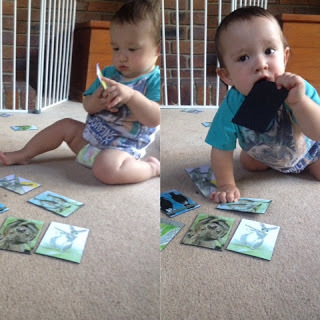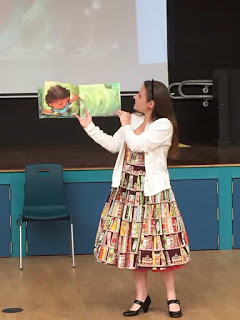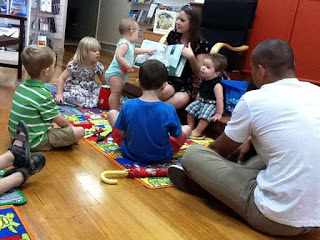Michelle Worthington's Blog, page 7
June 6, 2017
Top 10 tips for Connecting with Toddlers through Reading Time
Here are my top ten tips for Connecting with Your Little Ones.

• Build a foundation of communication and word structure for your child by helping them to become familiar with common sounds, words and language that you use throughout the day.
• Introduce them to the value of books by incorporating them into playtime as well as a bedtime routine.
• Talk about what you have read. Help your children understand that ideas need to be discussed and thought about critically and creatively. This will help show them that words can be communicated to other people in different ways to pass on the message. If you have read something you don’t agree with, discuss that as well. Children need to learn that everything this is written is not necessarily the truth.

• Find ways in everyday activities to spark your child’s imagination. Stimulate curiosity and help his brain development by using words creatively. Don’t be scared about using ‘big words’. Vocabulary is key to improving communication in young children.
• Use sounds in fun ways. Make silly made up sounds and vary your pitch and tone when talking, reading and singing songs together.
• Help your child learn the difference between ‘real’ and ‘make-believe’. Imaginative play with toys and books is a great way to switch from real life scenarios to make believe world building. Encourage made up stories but be clear about when the time is needed for truth.

• Picture books can be great tools for you to use to help your child understand change and new or frightening events, and also the strong emotions that can go along with them. The library is an amazing resource for finding diverse books.
• Stop and listen when your child is trying to tell you something. Maintain eye contact. Try to stay as still as you can. Your child will develop early literacy skills like the ability to listen to and understand words faster if they feel they themselves are being listened to and understood.
• Teach your child the importance of following simple instructions by writing shopping lists together and getting them involved with easy cooking recipes or reading aloud to them as you are cooking so they can see the importance of written words.

• Foster a sense of humour by sharing laughter every day. Laugh out loud at silly jokes, something accidental or unusual that happened or silly sounds. Learning to laugh is important for a child’s communication, literacy and emotional development. Best of all, the sound of your laughter will make them the happiest of all.
If you have some great top tips, I would love you to contact me.
www.michelleworthington.com
https://www.facebook.com/michelleworthington.author
twitter michelle_author
instagram michelle.author
www.michelleworthington.com

• Build a foundation of communication and word structure for your child by helping them to become familiar with common sounds, words and language that you use throughout the day.
• Introduce them to the value of books by incorporating them into playtime as well as a bedtime routine.
• Talk about what you have read. Help your children understand that ideas need to be discussed and thought about critically and creatively. This will help show them that words can be communicated to other people in different ways to pass on the message. If you have read something you don’t agree with, discuss that as well. Children need to learn that everything this is written is not necessarily the truth.

• Find ways in everyday activities to spark your child’s imagination. Stimulate curiosity and help his brain development by using words creatively. Don’t be scared about using ‘big words’. Vocabulary is key to improving communication in young children.
• Use sounds in fun ways. Make silly made up sounds and vary your pitch and tone when talking, reading and singing songs together.
• Help your child learn the difference between ‘real’ and ‘make-believe’. Imaginative play with toys and books is a great way to switch from real life scenarios to make believe world building. Encourage made up stories but be clear about when the time is needed for truth.

• Picture books can be great tools for you to use to help your child understand change and new or frightening events, and also the strong emotions that can go along with them. The library is an amazing resource for finding diverse books.
• Stop and listen when your child is trying to tell you something. Maintain eye contact. Try to stay as still as you can. Your child will develop early literacy skills like the ability to listen to and understand words faster if they feel they themselves are being listened to and understood.
• Teach your child the importance of following simple instructions by writing shopping lists together and getting them involved with easy cooking recipes or reading aloud to them as you are cooking so they can see the importance of written words.

• Foster a sense of humour by sharing laughter every day. Laugh out loud at silly jokes, something accidental or unusual that happened or silly sounds. Learning to laugh is important for a child’s communication, literacy and emotional development. Best of all, the sound of your laughter will make them the happiest of all.
If you have some great top tips, I would love you to contact me.
www.michelleworthington.com
https://www.facebook.com/michelleworthington.author
twitter michelle_author
instagram michelle.author
www.michelleworthington.com
Published on June 06, 2017 19:10
May 30, 2017
Top 5 Tips to get ASD kids reading.
Here are my top 5 tips to encourage young ASD children to fall in love with reading.

1.Let them pick what to read. Our local libraries love us. We almost always leave with 10 children's books. It works for us because it allows Tom to have a choice of what he wants to read based on whatever new obsession he has t hat week. I love the idea of teaching children to choose books on their own, regardless of their reading level. I love anything that encourages independence and I work with whatever motivated Tom to pick up that book, even if it is way above his comprehension level. Books are about so much more than words and pictures. They are about forming connections
2. Focus on sight words. Do everything you can to make them fun and playful but don't worry too much if they aren't picking it up straight away. This is a long term strategy for reading that needs to start early, way before they walk into a classroom. The more letters and words they recognise, the easier reading will be. It's not rocket science, it's repetition.
3. Make books available at play time, not just bedtime. We have books everywhere at our place. We keep them in in the playroom, in the kids’ bedroom and in the car. Bedtime is a lovely time to share stories but it is more about the senso ry stimulation they receive from being close to you than a learning experience. ASD kids respond well to using books as part of extending their play time by integrating literacy into their daily routine.
4. Read aloud. Even if it seems like they aren't listening, part of their brain is responding to the sounds of your voice. Varied tone, intonation and volume are important. Most importantly of all, it doesn’t have to be from a book. Read the paper, read the cereal packet, read the instructions on the packet meal for dinner. Get older siblings, grandparents or anyone who is willing to read aloud and then initiate a conversation with them about what they are reading. This encourages critical and creative thinking and associates books as a valued resource to facilitate easy conversation and connection with others.
5. Let them see you reading. ASD kids can be visual creatures who love to mimic others. If they see you reading, they a re more likely to do the same. Talk to them about what you are reading. Find a word they might recognise. Read varied books, magazines and online articles so they can see you use reading and books in your everyday life as an adult and they will grow to understand that even though reading might be difficult now, it will be a skill they will need when they get older so they will be more encouraged to stick with it.
If you would like to contact me, I would love to hear your top tips.
Website
www.michelleworthington.com
Facebook
https://www.facebook.com/michelleworthington.author
YouTubehttps://www.youtube.com/user/mworthingtonauthor
www.michelleworthington.com

1.Let them pick what to read. Our local libraries love us. We almost always leave with 10 children's books. It works for us because it allows Tom to have a choice of what he wants to read based on whatever new obsession he has t hat week. I love the idea of teaching children to choose books on their own, regardless of their reading level. I love anything that encourages independence and I work with whatever motivated Tom to pick up that book, even if it is way above his comprehension level. Books are about so much more than words and pictures. They are about forming connections
2. Focus on sight words. Do everything you can to make them fun and playful but don't worry too much if they aren't picking it up straight away. This is a long term strategy for reading that needs to start early, way before they walk into a classroom. The more letters and words they recognise, the easier reading will be. It's not rocket science, it's repetition.
3. Make books available at play time, not just bedtime. We have books everywhere at our place. We keep them in in the playroom, in the kids’ bedroom and in the car. Bedtime is a lovely time to share stories but it is more about the senso ry stimulation they receive from being close to you than a learning experience. ASD kids respond well to using books as part of extending their play time by integrating literacy into their daily routine.
4. Read aloud. Even if it seems like they aren't listening, part of their brain is responding to the sounds of your voice. Varied tone, intonation and volume are important. Most importantly of all, it doesn’t have to be from a book. Read the paper, read the cereal packet, read the instructions on the packet meal for dinner. Get older siblings, grandparents or anyone who is willing to read aloud and then initiate a conversation with them about what they are reading. This encourages critical and creative thinking and associates books as a valued resource to facilitate easy conversation and connection with others.
5. Let them see you reading. ASD kids can be visual creatures who love to mimic others. If they see you reading, they a re more likely to do the same. Talk to them about what you are reading. Find a word they might recognise. Read varied books, magazines and online articles so they can see you use reading and books in your everyday life as an adult and they will grow to understand that even though reading might be difficult now, it will be a skill they will need when they get older so they will be more encouraged to stick with it.
If you would like to contact me, I would love to hear your top tips.
Website
www.michelleworthington.com
https://www.facebook.com/michelleworthington.author
YouTubehttps://www.youtube.com/user/mworthingtonauthor
www.michelleworthington.com
Published on May 30, 2017 22:14
May 29, 2017
Connecting with your children through storytelling
Top tips for connecting with your children
 Thank so much to MyDeal.com.au for interviewing me on my best tips to connect with your children through reading together. You can find the full article here.
Thank so much to MyDeal.com.au for interviewing me on my best tips to connect with your children through reading together. You can find the full article here.
https://www.mydeal.com.au/blog/post/connecting-with-your-childrenwww.michelleworthington.com
 Thank so much to MyDeal.com.au for interviewing me on my best tips to connect with your children through reading together. You can find the full article here.
Thank so much to MyDeal.com.au for interviewing me on my best tips to connect with your children through reading together. You can find the full article here.https://www.mydeal.com.au/blog/post/connecting-with-your-childrenwww.michelleworthington.com
Published on May 29, 2017 22:28
Connecting with your chidlren through storytelling
Top tips for connecting with your children
 Thank so much to MyDeal.com.au for interviewing me on my best tips to connect with your children through reading together. You can find the full article here.
Thank so much to MyDeal.com.au for interviewing me on my best tips to connect with your children through reading together. You can find the full article here.
https://www.mydeal.com.au/blog/post/connecting-with-your-childrenwww.michelleworthington.com
 Thank so much to MyDeal.com.au for interviewing me on my best tips to connect with your children through reading together. You can find the full article here.
Thank so much to MyDeal.com.au for interviewing me on my best tips to connect with your children through reading together. You can find the full article here.https://www.mydeal.com.au/blog/post/connecting-with-your-childrenwww.michelleworthington.com
Published on May 29, 2017 22:28
3 Reasons Why Art Matters with MyDeal.com.au

3 Reasons Art is Great for Kids

Thank you so much to MyDeal.com.au for sharing my tips on the importance of reading to kids. Check out their blog for more great reasons on why Art is Great for Kids.https://www.mydeal.com.au/blog/post/3-reasons-art-is-great-for-kids
www.michelleworthington.com
Published on May 29, 2017 22:19
May 5, 2017
Fairy Belle reads The Wheelchair Adventure
Published on May 05, 2017 02:02
May 3, 2017
Have your picture book reviewed by a real life book fairy!
If you would like to have your children's picture book reviewed by Fairy Belle,
contact her at www.michelleworthington.com for more detailswww.michelleworthington.com
Published on May 03, 2017 15:49
April 26, 2017
Storytime Pup Children's Book Read Aloud: Each The Same. Stories for Kids.
Published on April 26, 2017 22:49
April 25, 2017
The Three Legged Kangaroo from Uluru
Published on April 25, 2017 22:45
Getting the most out of attending writers festivals
Published on April 25, 2017 18:18



